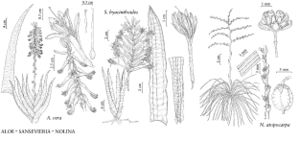Aloaceae
Trees, shrubs, and succulents, perennial, simple to sparsely branched, rhizomatous, some tuberous-thickened. Leaves simple, alternate, usually crowded at bases of stems or ends of branches, sessile; blade fleshy, margins often prickly, venation parallel. Inflorescences terminal, axillary, or lateral, spicate, racemose, or paniculate. Flowers 3-merous, short- to long-pedicellate, rarely sessile; perianth red, brown, yellow, orange, or whitish; tepals petaloid, connivent or connate basally to almost entirely into tube, sometimes fleshy; stamens sometimes 3, usually 6, exserted or included; anthers dorsifixed, dehiscence antrorse; pollen grains monosulcate; ovary 3-carpellate, placentation axile, usually with septal nectaries; style terminal; stigmas punctate, discoid, or 3-lobed. Fruits capsular, rarely baccate, dehiscence loculicidal, apical. Seeds usually winged or flattened.
Distribution
Introduced; All Africa, Madagascar, Arabia, and Atlantic islands.
Discussion
Genera 5, species ca. 700 (1 genus, 2 species in the flora).
Aloaceae are closely related to and included by some authors in Liliaceae.
The juice of some Aloe species is used to make a purgative called bitter aloe; active ingredients include aloin and other anthraquinones. Additionally, the thick, mucilaginous gel of some species is widely used to treat minor thermal burns, itching, and sunburn.
Selected References
None.
